Temperature is Key to Cooking Seafood!
Muscle fibers in fish are constructed of very short bundles (up to ten times shorter than the long muscle fibers in meat). And, compared to meat, fish muscle contains only a small fraction of connective tissue, which sits in very thin sheets perpendicular to the muscle bundles.
What does this all mean? To put it plainly, fish are more sensitive to heat, making it important to know the finished cook temp of fish! Here are ThermoWorks recommended fish temperatures for a few of our favorite cuts.
- Salmon doneness temp
- Halibut doneness temperature
- Lobster temps
- Scallop temps
- Shrimp temps
- Temps for seared tuna steaks
Salmon Temperature – 125°F
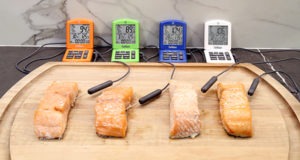
Salmon – like all fish – has almost no collagen, which means it will start to lose moisture more quickly than beef. While the FDA recommends cooking fish to 145°F, for a flakier, more moist and tender salmon filet, many chefs find that it’s best enjoyed when cooked to medium – 125°F. Check out these key temperatures for Smoked Salmon, or look at a great method for grilling salmon!
Halibut Temperature- 130°F
Halibut is a very firm fish and holds together well in cooking. This makes it particularly good for grilling. Too often it is overcooked and dry – the center should be just becoming opaque. It is done when it reaches an internal temperature between 130 and 135°F.
Want to learn more or try it out? Check out our post on delicious pan-seared halibut recipe, with a fantastic lemon-dill-butter sauce, or try grilling it.
Lobster Temperature- 140°F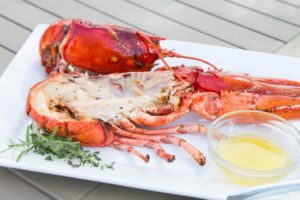
Cooking lobster is straightforward. But like most all seafood, due to its tightly-bound muscle structure and lack of the lubricating fat that makes cooking meat a more forgiving process, lobster cookery can go wrong easily. You want to cook lobster just through. Cooking it too much makes for a rubbery, dry and unfortunate situation, and too little will result in an odd texture and undeveloped flavors.
No matter how you cook you lobster, there seems to be agreement that lobster should be cooked to an internal temperature of 140°F, as measured in the tail. Whether you’re grilling lobster, or boiling or steaming it or homemade lobster rolls, keep an eye on that temp to avoid rubbery texture and to ensure tender, succulent lobster.
Scallops – Temperature 130°F
Because scallops are a lean protein source they should be cooked quickly under high heat and require some fat (such as oil or butter) during cooking. Cook to 130°F internal temperature until the flesh is milky white, or opaque and firm.
Shrimp – Temperature 140°F
Constriction is the tell-tale sign that you’ve overcooked your shrimp. The longer you cook them, the tighter and tougher they will get. Look for a change in color (light pink) and an internal temperature in the shrimp of 140°F to tell you when your shrimp are ready to come off the heat. A miniature needle probe is perfect for checking the internal temperature of shrimp.
Follow this recipe for grilled shrimp for more temperature tips to see how tasty they can be!
Or, try our buttery smoked shrimp!
Ahi Tuna Temperature – Rare – Below 115°F
Tuna is most often served rare or seared rare because the longer you cook it, the more flavor and moisture it loses. Tuna cooked rare is optimal in order to maintain flavor and moisture. Raw tuna frequently carries a parasite, but “Sashimi” grade fish has been flash frozen to kill any parasites. Restaurants that serve raw tuna are required to use Sashimi grade. If you want to try it, check out our delicious recipe for seared rare tuna steak.
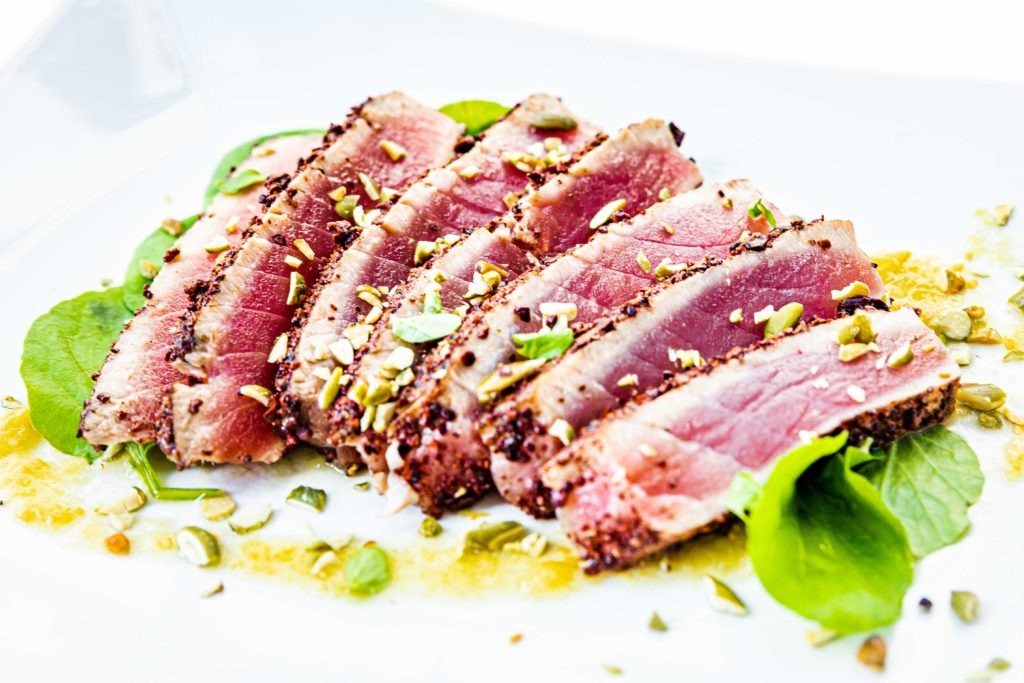
A Word On Thermometers For Cooking Fish
Depending on the cooking method and the kind of fish you’re cooking, you many need a different kind of thermometer. You can learn about the major types and what you should use in our post about what kind of thermometer you need.
More on Key Temperatures and Tools
*McGee, Harold. “On Food and Cooking: The Science and Lore of the Kitchen.” (pg. 220)

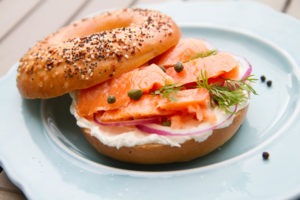
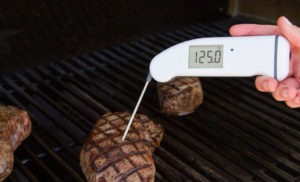

JNaka says
Great story Jesse, just wanted to make a clarification, actually the large tuna used for sashimi and sushi, are actually exempt from the freezing rule, as the worms they carry are not the type that make people ill.
Jeanine says
Thanks for the helpful temperature info. I always feel like I’m “winging it” when cooking seafood. Now I know what temperatures to look for & with my new Thermapen, cooking seafood will be a snap!
Kate says
Internal temperature for swordfish would be appreciated.
Martin says
Swordfish is much like tuna, best cooked like a steak. A nice medium-rare of 130–135°F is great!
Holly says
I would appreciate the internal temperature of Chilean Sea Bass.
Thank you!
Martin says
As it has a texture that is not unlike halibut, I’d go with 130°F for my finish temp.
Linda Mae Silva says
Help I need info on cooking abalone. I purchased canned abalone but don’t know to what temperature that I cook it too. Thinking breading it and cooking it in Irish butter.
Martin says
I’ve never cooked abalone before, but if it’s canned, then it’s already fully cooked. Dredging it in bread crumbs and frying it in butter until crisp sounds delicious, though!
Levi says
What about a “wet” cured bluefish in the smoker. I soak it for about 8 hours in a brine bath then into the smoker. What should I aim for an internal temp?
Martin says
I’d aim for 1350–135°F.
Val scenna says
I was always winging salmon until I bought the thermapen No mistakes or dried out salmon Thank you
Martin says
Wonderful to hear!